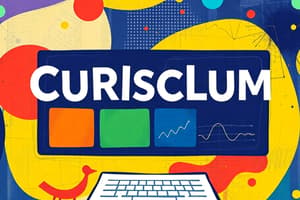Podcast
Questions and Answers
What does scope refer to in the context of the curriculum?
What does scope refer to in the context of the curriculum?
- The sequence of the curriculum
- The evaluation of the curriculum
- The coverage of the curriculum (correct)
- The assessment of the curriculum
How is the division of content in the curriculum achieved?
How is the division of content in the curriculum achieved?
- Using linear arrangement (correct)
- Using illogical arrangement
- Using random arrangement
- Using thematic arrangement
According to Smith, Stanley, and Shore (1957), what principle involves arranging content from simple to complex and concrete to abstract?
According to Smith, Stanley, and Shore (1957), what principle involves arranging content from simple to complex and concrete to abstract?
- Chronological Learning
- Prerequisite Learning
- Whole to Part Learning
- Simple to Complex Learning (correct)
What does 'Whole to Part Learning' principle entail?
What does 'Whole to Part Learning' principle entail?
What does 'Prerequisite Learning' mean in the context of curriculum organization?
What does 'Prerequisite Learning' mean in the context of curriculum organization?
Which principle is closely related to history, political science, or world events?
Which principle is closely related to history, political science, or world events?
According to Posner and Rudnitsky (1994), which major principle involves arranging contents in units based on their relationship with people, objects, or events of the world?
According to Posner and Rudnitsky (1994), which major principle involves arranging contents in units based on their relationship with people, objects, or events of the world?
What is the main focus of thematic arrangement in a curriculum?
What is the main focus of thematic arrangement in a curriculum?
'Linear Sequence' in a curriculum involves organizing contents and experiences in a:
'Linear Sequence' in a curriculum involves organizing contents and experiences in a:
What does scope in curriculum design refer to?
What does scope in curriculum design refer to?
According to Tyler (as cited in Ornstein & Hunkins, 2004), what does scope include?
According to Tyler (as cited in Ornstein & Hunkins, 2004), what does scope include?
What is the function of scope in curriculum design?
What is the function of scope in curriculum design?
What should be taken into consideration when determining the scope of a curriculum?
What should be taken into consideration when determining the scope of a curriculum?
What do curricularists suggest to view a design from?
What do curricularists suggest to view a design from?
What does scope provide boundaries for in curriculum design?
What does scope provide boundaries for in curriculum design?
Flashcards are hidden until you start studying
Study Notes
Curriculum Organization and Design
- Scope: Refers to the breadth and depth of the content covered in a curriculum, including the range of topics, themes, and subtopics.
Curriculum Division
- Content is divided into manageable units to facilitate learning, through various approaches, including:
Principles of Curriculum Organization
- Simple to Complex: Arranging content from simple to complex and concrete to abstract, as proposed by Smith, Stanley, and Shore (1957).
- Whole to Part Learning: Involves presenting the overall idea or concept and then breaking it down into smaller parts to facilitate understanding.
- Prerequisite Learning: Involves organizing content in a sequence where each new concept builds upon previously learned material.
- Chronological Organization: Closely related to history, political science, or world events, where content is arranged in a chronological order.
- Societal Organization: As proposed by Posner and Rudnitsky (1994), content is arranged in units based on their relationship with people, objects, or events of the world.
- Thematic Arrangement: Focuses on organizing content around central themes or ideas, providing a holistic understanding.
- Linear Sequence: Involves organizing contents and experiences in a sequential manner, where each step builds upon the previous one.
Scope in Curriculum Design
- Definition: According to Tyler (as cited in Ornstein & Hunkins, 2004), scope includes the breadth and depth of the content, as well as the range of topics, themes, and subtopics.
- Function: Provides boundaries for the curriculum, guiding the selection and organization of content.
- Considerations: When determining the scope of a curriculum, factors such as learners' needs, resources, and institutional requirements should be taken into account.
- Curricularists' Suggestion: To view a design from a broader perspective, considering the entire curriculum as a whole.
- Boundaries: Scope provides boundaries for the curriculum, limiting the content and ensuring focus on essential topics.
Studying That Suits You
Use AI to generate personalized quizzes and flashcards to suit your learning preferences.




